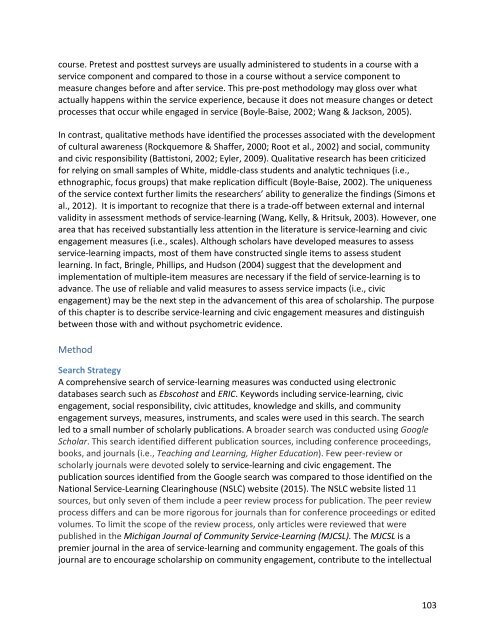A COMPENDIUM OF SCALES for use in the SCHOLARSHIP OF TEACHING AND LEARNING
compscalesstl
compscalesstl
Create successful ePaper yourself
Turn your PDF publications into a flip-book with our unique Google optimized e-Paper software.
course. Pretest and posttest surveys are usually adm<strong>in</strong>istered to students <strong>in</strong> a course with a<br />
service component and compared to those <strong>in</strong> a course without a service component to<br />
measure changes be<strong>for</strong>e and after service. This pre-post methodology may gloss over what<br />
actually happens with<strong>in</strong> <strong>the</strong> service experience, beca<strong>use</strong> it does not measure changes or detect<br />
processes that occur while engaged <strong>in</strong> service (Boyle-Baise, 2002; Wang & Jackson, 2005).<br />
In contrast, qualitative methods have identified <strong>the</strong> processes associated with <strong>the</strong> development<br />
of cultural awareness (Rockquemore & Shaffer, 2000; Root et al., 2002) and social, community<br />
and civic responsibility (Battistoni, 2002; Eyler, 2009). Qualitative research has been criticized<br />
<strong>for</strong> rely<strong>in</strong>g on small samples of White, middle-class students and analytic techniques (i.e.,<br />
ethnographic, focus groups) that make replication difficult (Boyle-Baise, 2002). The uniqueness<br />
of <strong>the</strong> service context fur<strong>the</strong>r limits <strong>the</strong> researchers’ ability to generalize <strong>the</strong> f<strong>in</strong>d<strong>in</strong>gs (Simons et<br />
al., 2012). It is important to recognize that <strong>the</strong>re is a trade-off between external and <strong>in</strong>ternal<br />
validity <strong>in</strong> assessment methods of service-learn<strong>in</strong>g (Wang, Kelly, & Hritsuk, 2003). However, one<br />
area that has received substantially less attention <strong>in</strong> <strong>the</strong> literature is service-learn<strong>in</strong>g and civic<br />
engagement measures (i.e., scales). Although scholars have developed measures to assess<br />
service-learn<strong>in</strong>g impacts, most of <strong>the</strong>m have constructed s<strong>in</strong>gle items to assess student<br />
learn<strong>in</strong>g. In fact, Br<strong>in</strong>gle, Phillips, and Hudson (2004) suggest that <strong>the</strong> development and<br />
implementation of multiple-item measures are necessary if <strong>the</strong> field of service-learn<strong>in</strong>g is to<br />
advance. The <strong>use</strong> of reliable and valid measures to assess service impacts (i.e., civic<br />
engagement) may be <strong>the</strong> next step <strong>in</strong> <strong>the</strong> advancement of this area of scholarship. The purpose<br />
of this chapter is to describe service-learn<strong>in</strong>g and civic engagement measures and dist<strong>in</strong>guish<br />
between those with and without psychometric evidence.<br />
Method<br />
Search Strategy<br />
A comprehensive search of service-learn<strong>in</strong>g measures was conducted us<strong>in</strong>g electronic<br />
databases search such as Ebscohost and ERIC. Keywords <strong>in</strong>clud<strong>in</strong>g service-learn<strong>in</strong>g, civic<br />
engagement, social responsibility, civic attitudes, knowledge and skills, and community<br />
engagement surveys, measures, <strong>in</strong>struments, and scales were <strong>use</strong>d <strong>in</strong> this search. The search<br />
led to a small number of scholarly publications. A broader search was conducted us<strong>in</strong>g Google<br />
Scholar. This search identified different publication sources, <strong>in</strong>clud<strong>in</strong>g conference proceed<strong>in</strong>gs,<br />
books, and journals (i.e., Teach<strong>in</strong>g and Learn<strong>in</strong>g, Higher Education). Few peer-review or<br />
scholarly journals were devoted solely to service-learn<strong>in</strong>g and civic engagement. The<br />
publication sources identified from <strong>the</strong> Google search was compared to those identified on <strong>the</strong><br />
National Service-Learn<strong>in</strong>g Clear<strong>in</strong>gho<strong>use</strong> (NSLC) website (2015). The NSLC website listed 11<br />
sources, but only seven of <strong>the</strong>m <strong>in</strong>clude a peer review process <strong>for</strong> publication. The peer review<br />
process differs and can be more rigorous <strong>for</strong> journals than <strong>for</strong> conference proceed<strong>in</strong>gs or edited<br />
volumes. To limit <strong>the</strong> scope of <strong>the</strong> review process, only articles were reviewed that were<br />
published <strong>in</strong> <strong>the</strong> Michigan Journal of Community Service-Learn<strong>in</strong>g (MJCSL). The MJCSL is a<br />
premier journal <strong>in</strong> <strong>the</strong> area of service-learn<strong>in</strong>g and community engagement. The goals of this<br />
journal are to encourage scholarship on community engagement, contribute to <strong>the</strong> <strong>in</strong>tellectual<br />
103


